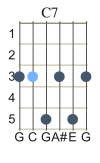Table of Contents
June 4th, 2013
These are notes from one of my Guitar Lessons.
Lesson 1 Practice Summary
1. Play the G Minor Pentatonic Scale
E 3 6 A 3 5 D 3 5 G 3 5 B 3 6 E 3 6
2. Play the 12 Bar Blues Progression
3 3 3 3 8 8 3 3 10 10 3 3
12 Bar Blues Progression
1 2 3 4 5 6 7 8 9 0 1 2 / / / / / / / / / / / / E A E B A E B G C G D C G D A D A E D A E B E B F#E B F# C F C G F C G D G D A G D A
Each slash is four beats (or strums). For now, we're sticking with simple down strums.
A7 Chord Shape
This is the A7 or Bar A chord shape. I'm not sure exactly what to call the shape itself (if the shape alone has a name). Played on the nut it's an A7, on the 3rd fret it's a C7, on the 8th an F7 and on the 10th a G7. We're just calling it A for now. This is the first bar chord that I've learned.
I believe I practiced this shape wrong.
My hand tires quickly when playing this chord. I need to practice it lots.
We played the chord with the bar on frets 3, 8. and 10 to complete the progression. This is a bit fuzzy in my memory, so I went to Wikipedia for a break down. It says that the progression is the following.
C7 C7 C7 C7 F7 F7 C7 C7 G7 G7 C7 C7
So, the frets are the following.
3 3 3 3 8 8 3 3 10 10 3 3
That doesn't exactly match the progression above. I may try it both ways. Here are the frets to play to match the progression listed above.
3 3 3 3 8 8 3 3 10 8 3 10
The Scale
We also talked about the fret scale. I had studied this a little on my own so understand the concept. It's easy to remember because it just goes from A to G and then repeats. Every other note is a sharp (#). There are two exceptions. There is no B# or E#.
On string 6 (E) the notes go like this.
0 E 1 F 2 F# 3 G 4 G# 5 A 6 A# 7 B 8 C 9 C# 10 D 11 D# 12 E
G Minor Pentatonic Scale
We walked through the G Minor Pentatonic Scale. That scale is a series of single notes. Strings are listed in the first column and the fret for each note in the 2nd and 3rd columns. Two notes are played for each string.
So, the first line is “E 3 6”. This means we'll play notes on the E string. The first note on the 3rd fret and the second on the 6th fret. The actual notes we're playing (on the first line) are G and then A#.
E 3 6 A 3 5 D 3 5 G 3 5 B 3 6 E 3 6
Three String Tuning
I had my homemade 3-string guitar tuned as DAD. I had a second to ask about this and Ginzo suggested using D A F# instead. I'll give that a try soon.
He also suggested putting marks on the guitar neck where frets would typically be. That will help me find the notes when I'm learning slide. I've been thinking about this and will need to come up with a good way to mark these.
D A F#
This should constitute Open D tuning. On a 6 string you would tune this D A D F♯ A D. It uses the three notes that form the triad of a D major chord: D, the root note; A, the perfect fifth; and F♯, the major third. So, on my 3-string, we just use those three notes.
Strumming all the strings produces a D Major. Second fret an E Major. Third fret an F Major, and so on.

